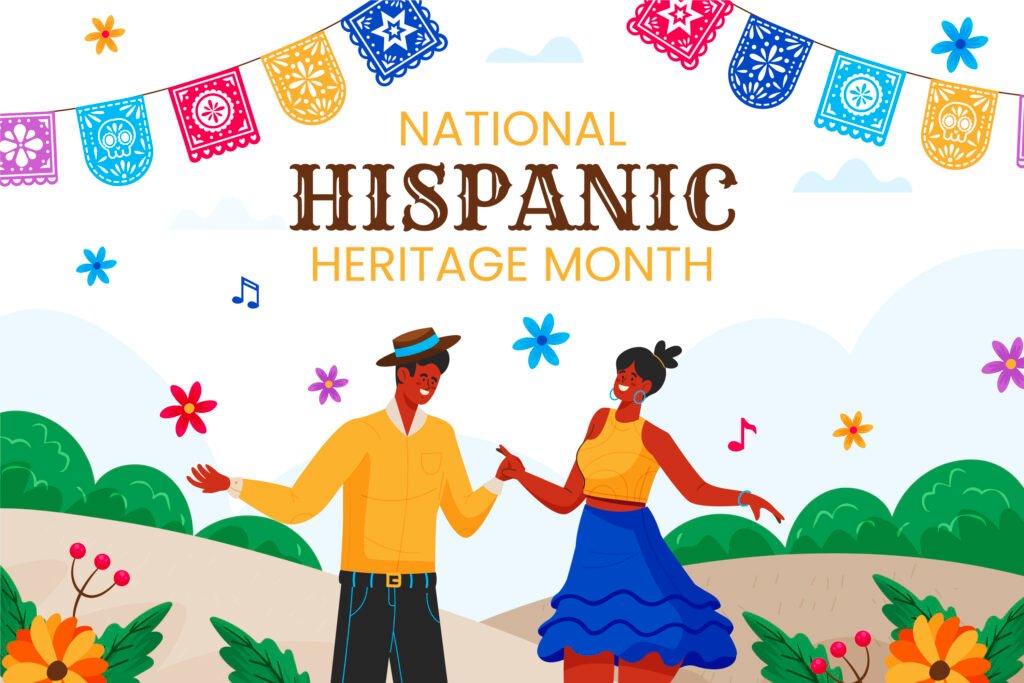Every year, from September 15 to October 15, the United States celebrates Hispanic Heritage Month, a time dedicated to honoring the rich cultural legacy and significant contributions of the Hispanic and Latino communities. This month-long celebration highlights the diverse cultures, histories, and achievements of Americans whose ancestors come from Spain, Mexico, the Caribbean, and Central and South America.
But what is Hispanic Heritage Month really about, and why is it so important to celebrate? This blog will explore the roots of this celebration, its impact on American society, and why it continues to hold relevance today.
The Origins of Hispanic Heritage Month
How It All Began
Hispanic Heritage Month traces its roots back to 1968, when it was first recognized as Hispanic Heritage Week under President Lyndon B. Johnson. The goal was to acknowledge the contributions of Hispanic and Latino communities to the history and culture of the United States. Twenty years later, in 1988, the celebration was expanded to a month by President Ronald Reagan, reflecting the growing influence and significance of Hispanic communities across the nation.
Why the Dates Matter
The choice of September 15 as the start date for Hispanic Heritage Month is symbolic. It coincides with the anniversaries of independence for several Latin American countries, including Costa Rica, El Salvador, Guatemala, Honduras, and Nicaragua, all of which declared independence from Spain in 1821. Additionally, Mexico celebrates its independence on September 16, and Chile on September 18. This month-long period allows for a reflection on these historic moments and the ongoing contributions of Latinos to U.S. culture, economy, and society.
Why Hispanic Heritage Month is Important
1. Celebrating Cultural Diversity
One of the main reasons Hispanic Heritage Month is important is its role in celebrating the cultural diversity that enriches the United States. Hispanic and Latino communities bring a rich tapestry of languages, traditions, and cultural practices that have shaped the nation. From Latin music and dance to food and art, Hispanic culture permeates every facet of American life. This celebration is a way to recognize and honor that diversity.
During Hispanic Heritage Month, cities across the U.S. host festivals, parades, art exhibits, and educational programs that showcase the richness of Hispanic culture. These events allow people of all backgrounds to experience the music, food, and traditions that are integral to Hispanic life.
2. Honoring Historical Contributions
Another key reason for Hispanic Heritage Month is to honor the historical contributions of Hispanic Americans. From politics and science to civil rights and the arts, Latinos have made significant impacts on the U.S.
Notable Hispanic Figures
- Cesar Chavez, a civil rights leader and labor organizer, fought for the rights of farm workers and co-founded the United Farm Workers.
- Sonia Sotomayor, the first Hispanic Supreme Court Justice, is a trailblazer in American law.
- Ellen Ochoa, the first Hispanic woman astronaut, made groundbreaking contributions to space exploration.
Honoring these figures during Hispanic Heritage Month reminds us of the important roles Latinos have played in shaping American history.
3. Educational Importance
Hispanic Heritage Month serves an essential educational function by increasing awareness and understanding of Hispanic and Latino history. Many schools, colleges, and universities across the U.S. host events, lectures, and activities aimed at educating students about the contributions and struggles of Hispanic communities.
Educational programs during the month also aim to dispel stereotypes and combat misconceptions about the Hispanic community, fostering a greater sense of inclusion and respect for diversity.
The Economic Contributions of Hispanics in the U.S.
A Growing Influence
Hispanic and Latino communities are not just culturally influential; they also play a significant role in the American economy. According to the U.S. Hispanic Chamber of Commerce, Hispanic-owned businesses contribute more than $800 billion to the U.S. economy each year, with the number of Hispanic entrepreneurs continuing to grow.
Latinos are also a critical component of the U.S. workforce, especially in industries such as agriculture, construction, and hospitality. However, their contributions extend well beyond these sectors, with Latinos making strides in education, technology, and business.
Empowering Future Generations
Celebrating Hispanic Heritage Month also highlights the importance of empowering future generations of Hispanic leaders. By recognizing the achievements of Latino entrepreneurs, scientists, activists, and public servants, we inspire the next generation of young Hispanic Americans to pursue their goals and contribute to their communities.
Programs aimed at mentoring Latino youth, expanding educational opportunities, and increasing representation in media and politics are vital for creating a more inclusive society.

Hispanic Heritage and the Arts
Celebrating Through Art and Music
One of the most vibrant ways to celebrate Hispanic Heritage Month is through the arts. Latino art, music, and dance have left an indelible mark on American culture. From salsa and merengue to reggaeton and ballet folklórico, Hispanic music and dance styles are widely embraced across the country.
Visual Arts
Latino artists like Frida Kahlo and Diego Rivera have gained global recognition for their work. Contemporary artists such as Jean-Michel Basquiat and Carmen Herrera have continued this legacy, contributing to the ongoing dialogue about identity, race, and culture through their art.
Hispanic Heritage Month is an ideal time to explore exhibitions and galleries showcasing Latino artists and their work. Museums and cultural institutions across the country frequently offer special exhibitions to honor the artistic contributions of Hispanic and Latino communities.
The Power of Storytelling
Latino authors have also made significant contributions to American literature. Writers like Sandra Cisneros, Gabriel García Márquez, and Isabel Allende have created works that explore themes of identity, migration, and family. Their stories often reflect the broader immigrant experience in the U.S. and resonate with readers from diverse backgrounds.
Through books, films, and other media, Hispanic Heritage Month provides an opportunity for storytelling that reflects the unique experiences of Latino communities in the U.S.
Challenges and the Road Ahead
Ongoing Struggles for Equality
While Hispanic Heritage Month is a celebration of the many contributions of Hispanic and Latino communities, it is also a time to reflect on the challenges that still face these communities. Latinos in the U.S. continue to grapple with issues like immigration reform, racial discrimination, and income inequality.
Hispanic Heritage Month serves as a platform to raise awareness of these ongoing struggles and to advocate for policies that support the Hispanic community’s quest for equality and justice. By focusing on both the successes and the challenges of Latino Americans, this month becomes a call to action for the future.
How You Can Get Involved
There are many ways to participate in Hispanic Heritage Month celebrations and support the Hispanic and Latino communities. Here are some ideas:
- Attend local events such as parades, festivals, or educational programs.
- Support Hispanic-owned businesses by shopping local or dining at Hispanic restaurants.
- Learn more about Hispanic history by reading books, watching documentaries, or attending lectures.
- Volunteer with organizations that work to support the Hispanic community.
- Engage in conversations about the importance of diversity and inclusion in your own community.
By participating in these activities, you can help raise awareness and celebrate the profound impact that Hispanic Americans have on the country.
FAQs
1. What is the purpose of Hispanic Heritage Month?
Hispanic Heritage Month celebrates the culture, history, and contributions of Hispanic and Latino Americans. It aims to honor the impact of Hispanic communities on the U.S. while also educating the public about Hispanic heritage.
2. Why is Hispanic Heritage Month celebrated from September 15 to October 15?
The dates were chosen to coincide with the independence anniversaries of several Latin American countries, including Costa Rica, Mexico, El Salvador, Guatemala, Honduras, and Nicaragua.
3. What are some key activities during Hispanic Heritage Month?
Hispanic Heritage Month features events such as cultural festivals, parades, educational workshops, art exhibitions, and community service projects.
4. How can I participate in Hispanic Heritage Month?
You can participate by attending local events, supporting Hispanic-owned businesses, learning more about Hispanic culture, and getting involved in advocacy efforts.
5. How does Hispanic Heritage Month help raise awareness of Hispanic issues?
In addition to celebrating culture, Hispanic Heritage Month also highlights issues affecting Latino communities, such as immigration, discrimination, and income inequality, encouraging action and advocacy.
Conclusion
Hispanic Heritage Month is an essential celebration of the diverse and rich contributions of Hispanic and Latino Americans. From honoring historical figures to celebrating cultural achievements in art, music, and literature, this month-long event provides a platform to recognize the incredible influence of Hispanic communities on American society.
As we celebrate Hispanic Heritage Month in 2024, it is important to remember that this is not just a time to reflect on the past, but also an opportunity to look toward the future. By supporting Hispanic communities, advocating for equality, and fostering cultural understanding, we can continue to build a more inclusive and diverse society.











